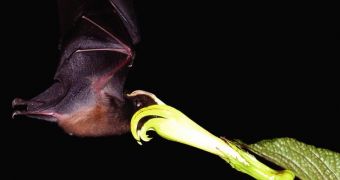There are bats whose diet relies on nectar. To feed on it, the bats have to hover like a bumblebee in front of the flower, while they extract the sweet juice with their long tongue. But current aerodynamic theories say bats are too large for this, but still do it.
A new research published in the journal "Science" and led by biologist Anders Hedenstr?m of Lund University, in Sweden, has attempted to explain this. Bats were placed into a smoky wind tunnel in order to investigate their flight with special cameras and lasers. The images revealed that bats used air vortexes just like many hovering insects.
"We imaged air flow around bats' wings to see how they shed these vortexes, which we think of as fingerprints. We found they give bats 40% more efficiency in hovering flight," said Hedenstr?m.
For the hovering flight, nectar-feeding bats flap their wings about 15 times per second. The images taken in the wind tunnel showed that a vortex formed at the front edge of the wing during each of its downward movements.
"This leading edge vortex then swirls around the wing during the upward stroke. It stays attached to the wing, almost like it's glued there. The 'sticky' vortex is like an air bubble that effectively changes the shape of the wing, forcing air to move around it in a more complex path," said Hedenstr?m.
The vortex lowers the air pressure above the wing, lifting the bat.
"Forward speed during flight generates lift, but hovering is all muscle power. You don't see animals much larger than this hovering, because they would need to beat their wings incredibly quickly. Insect wings are stiff while bat wings are incredibly flexible. We think they do it by flexing their membranous wings to change their curvature in mid-flight," said Hedenstr?m. For more details of the bat-hovering, much faster cameras are required. The team used cameras shooting 10 frames per second, slower than the wing flap rhythm of the bats.
"We were lucky if we got one good image per wing beat. Our new system will give us 20 times more speed. By researching bat flight, we can learn how to incorporate it into robots," Hedenstr?m said.

 14 DAY TRIAL //
14 DAY TRIAL //